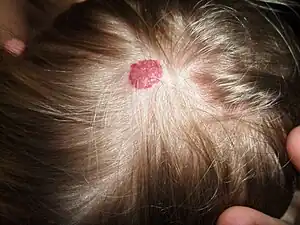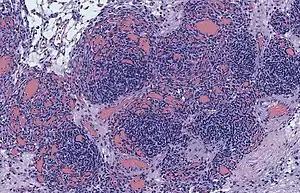Vascular tumor
| Vascular tumor | |
|---|---|
 | |
| A hemangioma, a benign type of vascular tumor | |
| Pronunciation |
|
| Specialty | Oncology |
| Symptoms | Bleeding, pain[2] |
| Types | Infantile hemangioma, congenital hemangioma, tuft angioma, pyogenic granuloma, angiofibroma, lymphangioma, hemangioendothelioma, Kaposi sarcoma, and angiosarcoma.[3][2] |
| Differential diagnosis | Vascular malformations[3] |
| Treatment | Observation, beta blockers, photocoagulation, embolization, surgery, radiation therapy, chemotherapy[4] |
| Frequency | Infantile hemangiomas 5%, others rare[2] |
Vascular tumors are a type of growth that forms from cells that make blood vessels or lymph vessels.[1] In around 30% of cases they are visible at birth while most of the rest form later in childhood.[3] Many will grow and than resolve spontaneously.[3] Symptoms may include bleeding or pain.[2] Complications of some types include blood-clotting problems.[5]
The most common type is infantile hemangioma.[3] Other types include congenital hemangioma, tuft angioma, pyogenic granuloma, angiofibroma, lymphangioma, hemangioendothelioma, Kaposi sarcoma, and angiosarcoma.[3][2] They can be benign or cancerous.[1] Diagnosis is by examination, medical imaging, and occasionally biopsy.[4]
Treatment depends on the specific type of tumor.[4] Options may range from observation, to beta blockers, steroids, photocoagulation, embolization, surgery, radiation therapy, or chemotherapy.[4] NSAIDs may be used to help with pain.[4]
Infantile hemangiomas occur in about 5% of babies.[2] Other vascular tumors are rare.[2] Lymphangiomas representing about 4% of vascular tumors.[6] Vascular tumors were historically described as "birthmarks".[3] In the mid 1800s Rudolf Virchow created the first classification system, while the current classification system was originally proposed in 1982.[3]
Classification
Vascular tumors make up one of the classifications of vascular anomalies. The other grouping is vascular malformations. Vascular tumors can be further subclassified as being benign, borderline or aggressive, and malignant. Vascular tumors are described as proliferative, and vascular malformations as nonproliferative.[7] A vascular tumor may be described in terms of being highly vascularized, or poorly vascularized , referring to the degree of blood supply to the tumor. An angioma refers to any type of benign vascular tumor.[8]
Types

A vascular tumor typically grows quickly by the proliferation of endothelial cells. Most are not birth defects.[7]
Benign
The most common type of benign vascular tumors are hemangiomas, most commonly infantile hemangiomas, and less commonly congenital hemangiomas.
Infantile hemangioma
Infantile hemangiomas are the most common type of vascular tumor to affect babies,[7] accounting for 90% of hemangiomas.[9] They are characterised by the abnormal proliferation of endothelial cells and of deviant blood vessel formation or architecture.[10] Hypoxic stress seems to be a major trigger for this.[11] Infantile hemangiomas are easily diagnosed, and little if any aggressive treatment is needed.[11] They are characterised by rapid growth in the first few months, followed by spontaneous regression in early childhood.[9]
Congenital hemangioma
Congenital hemangiomas are present and fully formed at birth,[9] and only account for 2% of the hemangiomas. They do not have the postnatal phase of proliferation common to infantile hemangiomas.[10] There are two main variants of congenital hemangioma: non-involuting, and rapidly involuting (beginning in the first year of life).[10] A third variant is also recognised as partially involuting.[12] Congenital hemangiomas can also be distinguished from infantile hemangiomas in that neither variant of congenital hemangioma expresses the glucose transporter GLUT 1.[10][13]
Some cases have been associated with a mild form of thrombocytopenia. Rare cases have been associated with heart failure.[10]
Hemangioblastoma
Hemangioblastomas are vascular tumors of the central nervous system.
Pyogenic granuloma
A range of benign vascular tumors are described as reactive proliferative lesions that grow in response to a stimulus, such as trauma, or a local thrombosis. They can also form infrequently during pregnancy as a hormonal reaction affecting the gums.[14]
The most common type of reactive proliferative tumors are pyogenic granulomas also known as lobular capillary hemangiomas, that are more often found in children and young adults.[7] These granulomas are well defined growths of less than a centimetre across. They are bright red due to being highly vascularised, and bleed and ulcerate easily.[14] Their colouring fades with age.[7]
Tufted angioma
Tufted angiomas are hereditary hemangiomas found in infants from birth to five years of age, however they may occur in adults. They are found on the neck, shoulders, and trunk as rounded nodules.[15] Tufted angiomas are usually poorly defined lesions of purple colouration.[16] The tumors are of tufts of capillary-sized vessels in lobules that are scattered in the skin, and that sometimes reach into the subcutaneous tissue, and have lymph vessels on the periphery. Their growth is slow to begin with, and progresses to a stable size. They show a high rate of spontaneous regression, particularly in congenital and early-onset cases.[16] They typically have a deep nodular component sometimes extending into the subcutaneous tissue, fascia, and muscle, and can sometimes be painful.[16] Tufted angiomas are associated with arteriovenous malformations.[16]
The origin of tufted angiomas is not clear but markers on the cells suggest a possible derivation from the endothelial cells of lymph vessels.[15] They are also associated with the local secretion of growth factors that affect angiogenesis and promote the development of vascular lobules.[16]
Borderline

Kaposiform hemangioendotheliomas (KHEs) are borderline, locally destructive vascular tumors.[7] They are named after their resemblance to the lesions of Kaposi's sarcoma.[17] KHEs are described as locally destructive because they can infiltrate underlying muscle and fat.[7] They are often seen to overlap with tufted angiomas (TAs) but TAs may be a milder, benign counterpart.[18]
KHEs show as a red or purple expanding mass of soft tissue,[18] found mostly in infants. Under the microscope KHE is characterised by nodules of tumor-like spindled endothelial cells.[18] Unlike infantile hemangiomas, KHEs have a high mortality rate.[18] Both KHEs and TAs are unique in that they carry the risk of the development of Kasabach–Merritt syndrome.[19]
Malignant
Malignant vascular tumors are rare,[11] and include angiosarcomas, and epithelioid hemangioendotheliomas.[7] Other types are hemangiopericytomas,[20] and lymphangiosarcomas.
See also
References
- 1 2 3 "NCI Dictionary of Cancer Terms". National Cancer Institute. 2 February 2011. Archived from the original on 23 November 2020. Retrieved 15 November 2019.
- 1 2 3 4 5 6 7 "Childhood Vascular Tumors Treatment (PDQ®)–Health Professional Version - National Cancer Institute". www.cancer.gov. 28 January 2016. Archived from the original on 18 March 2021. Retrieved 24 February 2021.
- 1 2 3 4 5 6 7 8 Sepulveda, A; Buchanan, EP (May 2014). "Vascular tumors". Seminars in plastic surgery. 28 (2): 49–57. doi:10.1055/s-0034-1376260. PMID 25045329.
- 1 2 3 4 5 "Childhood Vascular Tumors Treatment (PDQ®)–Patient Version - National Cancer Institute". www.cancer.gov. 23 May 2016. Archived from the original on 18 March 2021. Retrieved 24 February 2021.
- ↑ Johnson, EF; Davis, DM; Tollefson, MM; Fritchie, K; Gibson, LE (April 2018). "Vascular Tumors in Infants: Case Report and Review of Clinical, Histopathologic, and Immunohistochemical Characteristics of Infantile Hemangioma, Pyogenic Granuloma, Noninvoluting Congenital Hemangioma, Tufted Angioma, and Kaposiform Hemangioendothelioma". The American Journal of Dermatopathology. 40 (4): 231–239. doi:10.1097/DAD.0000000000000983. PMID 29561329.
- ↑ DeLong, Leslie; Burkhart, Nancy W. (2007). General and Oral Pathology for the Dental Hygienist. Lippincott Williams & Wilkins. p. 417. ISBN 978-0-7817-5546-7. Archived from the original on 2021-08-27. Retrieved 2021-02-24.
- 1 2 3 4 5 6 7 8 Steiner, JE; Drolet, BA (September 2017). "Classification of Vascular Anomalies: An Update". Seminars in Interventional Radiology. 34 (3): 225–232. doi:10.1055/s-0037-1604295. PMC 5615389. PMID 28955111.
- ↑ "Dorlands Medical Dictionary:angioma". web.archive.org. 2 February 2009. Archived from the original on 2 February 2009. Retrieved 30 July 2022.
{{cite web}}: CS1 maint: bot: original URL status unknown (link) - 1 2 3 Sadick, M; Müller-Wille, R; Wildgruber, M; Wohlgemuth, WA (September 2018). "Vascular Anomalies (Part I): Classification and Diagnostics of Vascular Anomalies". RoFo : Fortschritte Auf dem Gebiete der Rontgenstrahlen und der Nuklearmedizin. 190 (9): 825–835. doi:10.1055/a-0620-8925. PMID 29874693.
- 1 2 3 4 5 Darrow, DH; Greene, AK; Mancini, AJ; Nopper, AJ; SECTION ON DERMATOLOGY, SECTION ON OTOLARYNGOLOGY–HEAD AND NECK SURGERY, and SECTION ON PLASTIC, SURGERY. (October 2015). "Diagnosis and Management of Infantile Hemangioma". Pediatrics. 136 (4): e1060-104. doi:10.1542/peds.2015-2485. PMID 26416931.
{{cite journal}}: CS1 maint: multiple names: authors list (link) - 1 2 3 Wildgruber, M; Sadick, M; Müller-Wille, R; Wohlgemuth, WA (13 March 2019). "Vascular tumors in infants and adolescents". Insights into Imaging. 10 (1): 30. doi:10.1186/s13244-019-0718-6. PMC 6419671. PMID 30868300.
- ↑ "Congenital haemangioma". www.gosh.nhs.uk. Archived from the original on 2020-08-04. Retrieved 2019-11-22.
- ↑ van Vugt, LJ; van der Vleuten, CJM; Flucke, U; Blokx, WAM (June 2017). "The utility of GLUT1 as a diagnostic marker in cutaneous vascular anomalies: A review of literature and recommendations for daily practice". Pathology, Research and Practice. 213 (6): 591–597. doi:10.1016/j.prp.2017.04.023. PMID 28552538.
- 1 2 Kumar, V; Abbas, A; Aster, J (2018). Robbins basic pathology (Tenth ed.). pp. 392–396. ISBN 9780323353175.
- 1 2 "MeSH Browser". meshb.nlm.nih.gov. Archived from the original on 19 January 2021. Retrieved 22 November 2019.
- 1 2 3 4 5 Victoria Martínez, AM; Cubells Sánchez, L; Esteve Martínez, A; Estela Cubells, JR; Febrer Bosch, I; Alegre de Miquel, V; Oliver Martínez, V (September 2015). "[Tufted angiomas in childhood: A series of 9 cases and a literature review]". Anales de Pediatria (Barcelona, Spain : 2003). 83 (3): 201–8. doi:10.1016/j.anpedi.2014.10.018. PMID 25468452.
- ↑ Vivas-Colmenares, GV; Ramirez-Villar, GL; Bernabeu-Wittel, J; Matute de Cardenas, JA; Fernandez-Pineda, I (January 2015). "The importance of early diagnosis and treatment of kaposiform hemangioendothelioma complicated by Kasabach-Merritt phenomenon". Dermatology Practical & Conceptual. 5 (1): 91–3. doi:10.5826/dpc.0501a18. PMC 4325701. PMID 25692091.
- 1 2 3 4 Putra, J; Gupta, A (June 2017). "Kaposiform haemangioendothelioma: a review with emphasis on histological differential diagnosis". Pathology. 49 (4): 356–362. doi:10.1016/j.pathol.2017.03.001. PMID 28438388.
- ↑ Croteau, SE; Gupta, D (September 2016). "The clinical spectrum of kaposiform hemangioendothelioma and tufted angioma". Seminars in Cutaneous Medicine and Surgery. 35 (3): 147–52. doi:10.12788/j.sder.2016.048. PMID 27607323.
- ↑ Ghose, A; Guha, G; Kundu, R; Tew, J; Chaudhary, R (June 2017). "CNS Hemangiopericytoma: A Systematic Review of 523 Patients". American Journal of Clinical Oncology. 40 (3): 223–227. doi:10.1097/COC.0000000000000146. PMID 25350465.